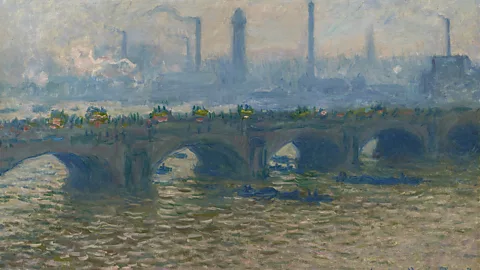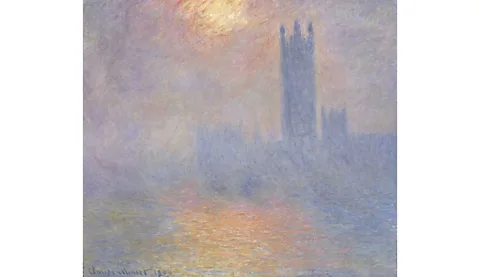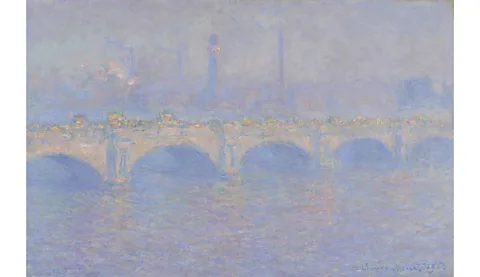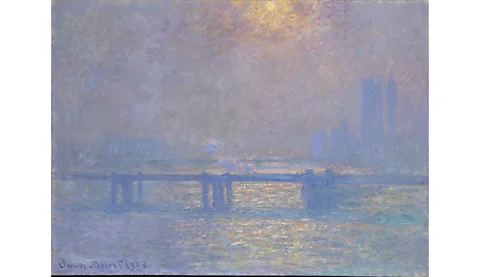 Christie’s Images
Christie’s ImagesA new exhibition charts how Claude Monet’s revolutionary, fog-shrouded visions of the Thames would “irreversibly alter how London saw itself”.
Some artists help us perceive the world more precisely. A rare few go further. They look beyond looking. Theirs is a deeper reality, more felt than seen. Claude Monet is one of those. In three visits to London between 1899 and 1901, the French Impressionist, then approaching 60 years of age, embarked upon one of the most ambitious series of penetrating paintings ever undertaken by any artist – a project that is now the focus of a groundbreaking exhibition at the Courtauld Institute, Monet and London: Views of the Thames.
From a murky miasma of toxic, soot-laced smog that choked the very breath of the Thames, Monet magicked up nearly 100 paintings – more than he would devote to any other subject in his long career. His evanescent visions, which dissolve the heft of London’s crowded bridges and imposing palaces into intangible tapestries of vibrating vapour, would shape forever the way the world conceived of the “unreal city”, as TS Eliot would later call it – a place beyond place that sits outside of time, an ethereal elsewhere.
Consider the evaporative power of a single instalment of the sprawling series, London, The Houses of Parliament, Shaft of Sunlight in the Fog. Among the best known of Monet’s views of the Thames, the painting captures the propulsive turrets of the Palace of Westminster, juddering in a flash of late-afternoon sun that teasingly transparentises a curtain of fog that shrouds the neo-Gothic structure.
During the artist’s second stay in London in 1901, Monet began chronicling the fluctuating temperaments of the Houses of Parliament from a covered terrace of the recently constructed St Thomas’s Hospital, directly across the river from the palace on the Southbank. A year earlier, the artist had begun translating, from the balcony of his sixth-floor rooms in the Savoy Hotel where the series began in September 1899, the shifting dispositions of dawn light as it alchemised the rigid reach of Waterloo Bridge and Charing Cross Bridge into luminous levitations. The ensuing studies of the Houses of Parliament, caught at different times of the day and in varying densities of smog and mist, demonstrate a further intensification of the artist’s understanding of the very essence of his subject.
 Musée d’Orsay, Paris, Photo: Grand Palais RMN (Musée d’Orsay
Musée d’Orsay, Paris, Photo: Grand Palais RMN (Musée d’OrsayWhile Monet’s work is often celebrated for its exquisite portrayal of light, there is a slight, though significant, imprecision in the praise. What distinguishes his paintings from those of Pissarro, Morisot and his other Impressionist peers is their conviction in the annihilating potential of sun-soaked air, which Monet sees as key to comprehending the ephemerality of form. The world is a mesmerising mirage. Through the lens of Monet’s painting, form – no matter how stony or static, intransigent or inert – is fungible. It fights for survival.
On first seeing a display of Monet’s London paintings five years later, a US collector and writer attested to the retinal riddle presented by Monet’s enthralling canvases, which seem to reverse the respective concretions of material substance and refulgent air. The urban infrastructures, Desmond FitzGerald explained: “are all so misty that at first the beholder gazes with astonishment at what seems to be a half-finished picture; but gradually, as the eye penetrates the fog, objects begin to come out… The illusion is wonderful, and has never been attempted in exactly the same manner before. The Houses of Parliament shine out of the fog with the colour of old-rose or purple.”
FitzGerald’s insistence that what Monet had seized was at once “an illusion” and something never before articulated by an artist is telling. Introduced into English in the middle of the 14th Century, the word “illusion” is related to “ludicrous” and initially denoted a jeering act of mocking deception. Is it possible that Monet’s mesmeric depictions of the Thames differ so markedly from those of earlier artists because they don’t, in fact, capture his subject as it actually appeared? Are his paintings, in truth, resplendent lies?
‘Light was in the air’
Monet was the first to confess that in order to make London a suitable subject for him to take on, a fabricating Insta-filter was required. “Without the fog,” he remarked, “London wouldn’t be a beautiful city. It’s the fog that gives it its magnificent breadth. Its regular and massive blocks become grandiose within that mysterious cloak.” The sheer panic that Monet suffered when he pulled back the curtains in his hotel room – to discover the crisp, clean light of a mistless morning – is palpable. “Upon getting up,” he confided to his wife in a letter written in March 1900, “I was terrified to see that there was no fog, not even the hint of mist; I was devastated and already seeing all my canvases ruined.” His relief when, “little by little, with the fires lighting up, smoke and mist returned,” only corroborates the suspicion that London, as a place, was all but incidental to his purposes. What he was really compiling weren’t studies of a city but experiments in optics – a pioneering treatise on the undiscovered properties of light itself.
 Image Courtesy of the Milwaukee Art Museum. Photo: John R Glembin
Image Courtesy of the Milwaukee Art Museum. Photo: John R GlembinIt is among the more intriguing, and under-explored, cultural coincidences that Monet’s audacious series, which provocatively posits light as pulsing parcels deftly described in short brushstrokes, began at the same moment that, in Germany, the theoretical physicist Max Planck was celebrating a breakthrough in his own conception of light as quanta, or packets of energy. Light, it seems, was in the air. By seizing upon the murky medium of virulent vapours spewing from the chimneys of the factories that crammed the banks of the river – Blake’s “dark satanic mills” – Monet painstakingly tested his paradoxical hypothesis that what is most worth seeing is what is least visible: the vibrating veil that invigorates reality.
So acclimatised are our eyes to seeing the Thames through the smudgy lens of Monet’s scintillating smoggles, it is almost impossible to imagine how the river could be perceived before he made us aware of the weave of fog’s “mysterious cloak”. Writing in the same year that Monet first set up his easel in the Savoy, Oscar Wilde wrestled with the very existence of fog in his essay The Decay of Lying. “At present, people see fogs, not because there are fogs,” Wilde mused: “but because poets and painters have taught them the mysterious loveliness of such effects. There may have been fogs for centuries in London. I dare say there were. But no one saw them, and so we do not know anything about them. They did not exist till Art had invented them.”
As if commenting directly on Monet’s works, which would not be shown for another five years, Wilde concludes that: “things are because we see them, and what we see, and how we see it, depends on the Arts that have influenced us. To look at a thing is very different from seeing a thing. One does not see anything until one sees its beauty.” Monet’s disassembly of soot-laced fog into a diaphanous fabric (replete with “all sorts of colours”, as the artist himself explained; “there are black, brown, yellow, green, purple fogs”) would soon supersede the visions of his predecessors and irreversibly alter how London saw itself.
 Art Institute of Chicago/Art Resource, NY/Scala, Florence
Art Institute of Chicago/Art Resource, NY/Scala, FlorenceSet side-by-side comparable views of the Thames by Monet and by his esteemed British forebear, JMW Turner, to whom the Impressionist was occasionally likened, and it is difficult to believe that the two artists set their easels in the same city. Turner’s 1830-35 painting The Thames Above Waterloo Bridge, which glimpses the city from a similar vantage to Monet’s Waterloo Bridge, Sunlight Effect, 1900, illustrates the divergence. While both artists are obsessed with light, for Turner the Sun was a muscular god, not a fine hook ripping at the threads holding reality together. In Turner’s canvas, smoke belching forth from a factory is not a blessing but a scar. The dark billows seem to assume the shape of a yelping black dog, leaping from a chimney, scratching at the sky. The poisonous pollution is an irritation, not a revelation.
To appreciate just how revolutionary Monet’s vision of London was at the turn of the 20th Century, one need merely compare it with that of his younger self. Thirty years earlier, the fledgling artist, then in his late 20s, took refuge in London, fleeing his hometown of Le Havre to avoid fighting in the Franco-Prussian War. An early painting by Monet that he undertook at the time, The Thames below Westminster, 1871, illustrates the instinctive allure fog held for him and finds the emerging artist gracefully weighing the relative gravities of light and levitations of architecture, as the Houses of Parliament begin to lose themselves in the tightening fabric of fog. But what holds our focus is not the strobing analysis of light’s essence that we find in his later paintings, such as Charing Cross Bridge, The Thames, 1903, but the rigid armature of the wooden pier we see being constructed clamorously on the right of the canvas. The fog is vivid, not yet vital.
 Musée des Beaux-Arts, Lyon, Image Lyon MBA. Photo: Alain Bass
Musée des Beaux-Arts, Lyon, Image Lyon MBA. Photo: Alain BassThough we tend to think of Impressionism as a movement devoted to capturing – quickly and at first hand – fleeting moments, Monet’s London series succeeded in turning this ideology on its head. Far from chronicling transitory glimmers, the Thames paintings are complex compressions of multiple moments artificially fused, reworked continuously over an expanse not of minutes but years. Rather than tending to a single canvas at a time, Monet would strew about his hotel room scores of fragmentary studies – fits-and-starts he would fumble for when a particular cohesion of mist, smoke and sunlight would reappear again. As no given light effect would linger more than a few minutes, every canvas is a palimpsest of echoing atmospherics.
Back in his studio in Giverny, Monet spent four years revising his visions in an effort to coax from their archaeologies of light harmonies that could hold them together like a symphony. The result is an immersive, misunderstood, multi-panel masterpiece that was scattered to the four winds when the paintings were sold off individually to international collectors. The Courtauld’s exhibition offers a precious opportunity to surround oneself with more than a third of the works that Monet started between 1899 and 1901 – a convergence of wonder that shaped the way we see and, like the miracles of light they capture, may never occur again.
Monet and London. Views of the Thames is at the Courtauld Gallery, London, until 19 Jan 2025.

